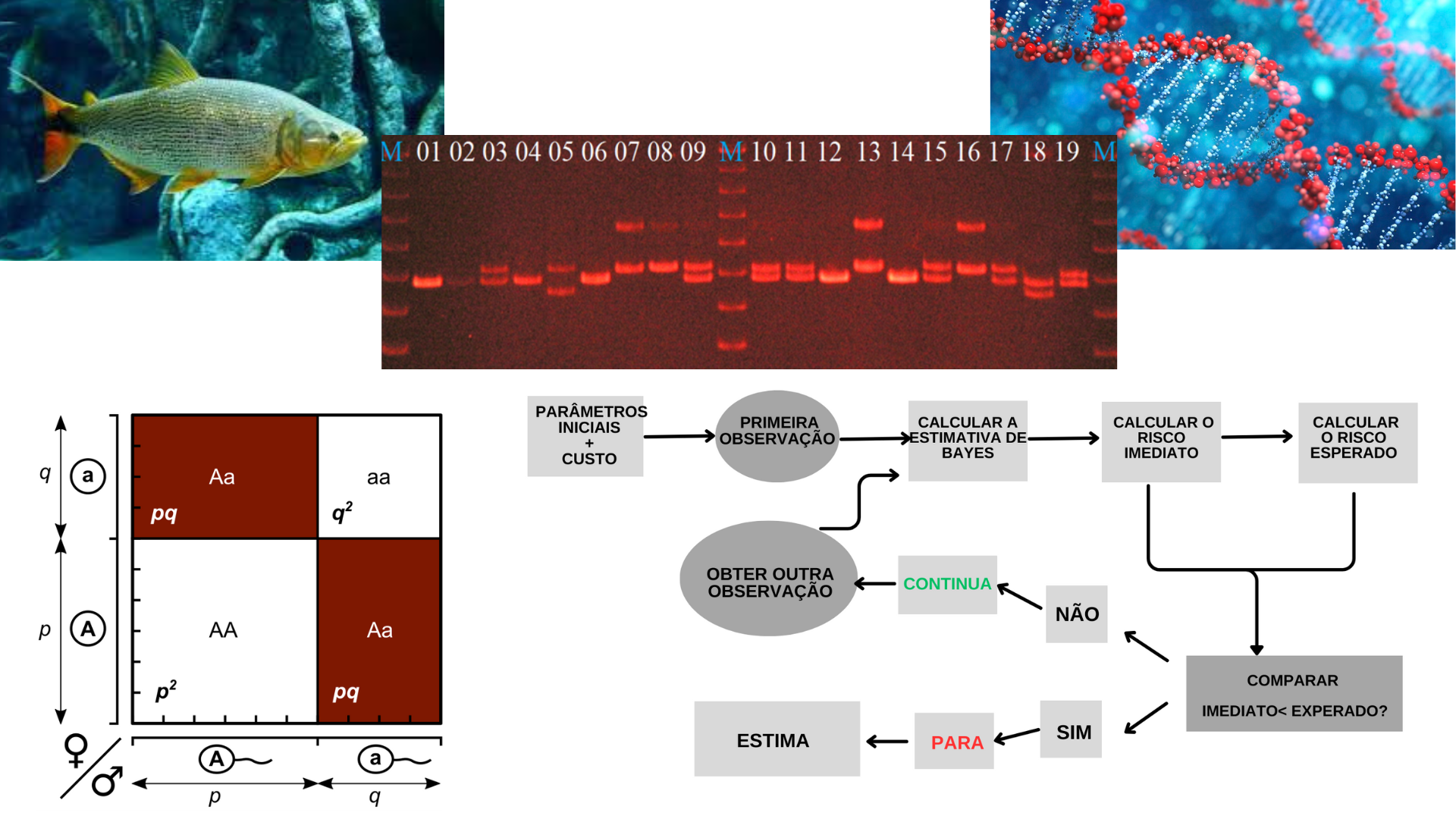Bayesian sequential estimation of the proportion of loci in Hardy-Weinberg equilibrium
Keywords:
Binomial distribution, Population genetics, Salminus brasiliensisAbstract
The Bayesian sequential approach uses samples of variable size, without the need to determine the size beforehand. The decision to stop sampling is based on a stopping criterion that compares risks. This approach is useful in processes involving destructive samples, with high time and financial costs, or in situations where the sample size is not defined by a pre-established rule. Given this, this approach can be used in the context of population genetics to estimate the proportion of loci in Hardy-Weinberg equilibrium (HWE), as there is no standard for the quantity of loci selected for population characterization. Due to the high cost and time involved in laboratory operations, loci are selected based on available resources. The objective of this study was to estimate the proportion of loci in HWE using the Bayesian sequential approach to characterize the genetic variability of the golden dorado (Salminus brasiliensis). Each locus was checked for HWE. Since the response variable is binary (in HWE or not), the associated probability distribution is binomial. A conjugate beta prior was used, whose hyperparameters were calculated based on previous analyses. Therefore, using the risk comparison criterion, after evaluating equilibrium in 28 loci, the process was terminated. Considering a quadratic loss function, the estimation is given by the mean of the posterior beta distribution, resulting in an estimate of 50%.
References
ALI, S. Mixture of the inverse Rayleigh distribution: Properties and estimation in a Bayesian framework. Applied Mathematical Modelling, v.39, n.2, p.515-530, 2015.
BACH, D. R. A cost minimisation and bayesian inference model predicts startle reflex modulation across species. Journal of Theoretical Biology, v.370, p.53–60, 2015.
BERGER, J. O. Statistical decision theory and Bayesian analysis. 2. ed. New York: Springer Science & Business Media, 1985. 617p.
BRIGHENTI, C. R. G.; RESENDE, M.; BRIGHENTI, D. M. Estimação sequencial bayesiana aplicada à proporção de infestação de psilídeos em alecrim do campo. Revista Brasileira de Biometria, v.29, n.2, p.342–354, 2011.
BUSSAB, W. O.; MORETTIN, P. A. Estatística Básica. 9. ed. São Paulo: Editora Saraiva, 2017. 568p.
CARMO, F. M. d. S.; POLO, É. M.; SILVA, M. A. d.; YAZBECK, G. M..Optimization of heterologous microsatellites in Piracanjuba. Pesquisa Agropecuária Brasileira, v.50, p. 1236-1239, 2015.
CASELLA, G.; BERGER, R. L. Statiscal Inference. 2. ed. df: Duxbury Press, 2002. 686p.
CHAGAS, K. P. T.; SOUSA, R. F.; FAJARDO, C. G.; VIEIRA, F. A. Seleção de marcadores ISSR e diversidade genética em uma população de Elaeis guineensis. Revista Brasileira de Ciências Agrárias, v.10, n.1, p.147-152, 2015.
HARTL, D. L.; CLARK, A. G. Princípios de Genética de Populações. 4. ed. Porto Alegre: Artmed. 2010. 659p.
LIMA. I. S. Estatística sequencial bayesiana dos parâmetros da distribuição multinomial. Dissertação de mestrado. Universidade Federal de Lavras, Lavras, 2022.
PHAM-GIA, T. Distribution of the stopping time in Bayesian sequential sampling. Australian & New Zealand Journal of Statistics, v.40, n.2, p. 221–227, 1998.
PRATT, J. W.; RAIFFA, H.; SCHLAIFER, R. The foundations of decision under uncertainty: An elementary exposition. Journal of the American statistical association, v.59, n.306, p.353–375, 1964.
R CORE TEAM. R: A language and environment for statistical computing. R Foundation for Statistical Computing, Vienna, Austria. 2023. ISBN 3-900051-07-0, URL http://www.R-project.org/.
REIS, R. L. d.; MUNIZ, J. A.; SILVA, F. F.; SÁFADI, T.; AQUINO, L. H. d. Comparação bayesiana de modelos com uma aplicação para o equilíbrio de Hardy-Weinberg usando o coeficiente de desequilíbrio. Ciência Rural, v.41, n.5, p.834–840, 2011.
SCHILLING, E. G.; NEUBAUER, D. V.Acceptance sampling in quality control. London: Crc Press, 2017. 882p.

Downloads
Published
How to Cite
Issue
Section
License
Proposta de Política para Periódicos de Acesso Livre
Autores que publicam nesta revista concordam com os seguintes termos:
- Autores mantém os direitos autorais e concedem à revista o direito de primeira publicação, com o trabalho simultaneamente licenciado sob a Licença Creative Commons Attribution que permite o compartilhamento do trabalho com reconhecimento da autoria e publicação inicial nesta revista.
- Autores têm autorização para assumir contratos adicionais separadamente, para distribuição não-exclusiva da versão do trabalho publicada nesta revista (ex.: publicar em repositório institucional ou como capítulo de livro), com reconhecimento de autoria e publicação inicial nesta revista.
- Autores têm permissão e são estimulados a publicar e distribuir seu trabalho online (ex.: em repositórios institucionais ou na sua página pessoal) a qualquer ponto antes ou durante o processo editorial, já que isso pode gerar alterações produtivas, bem como aumentar o impacto e a citação do trabalho publicado (Veja O Efeito do Acesso Livre).



